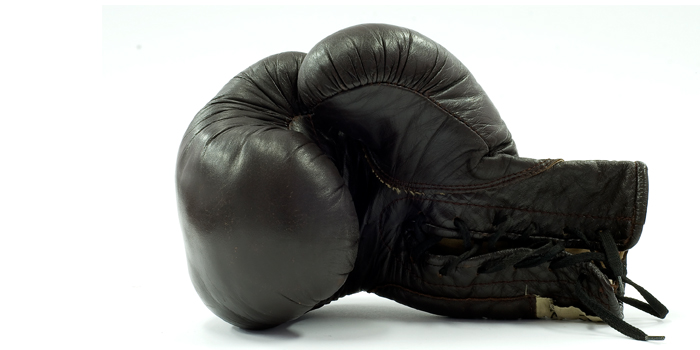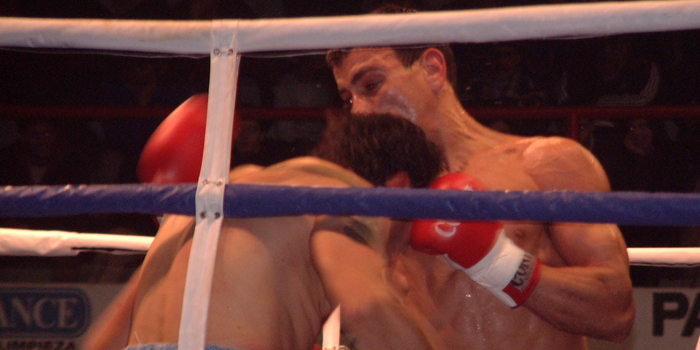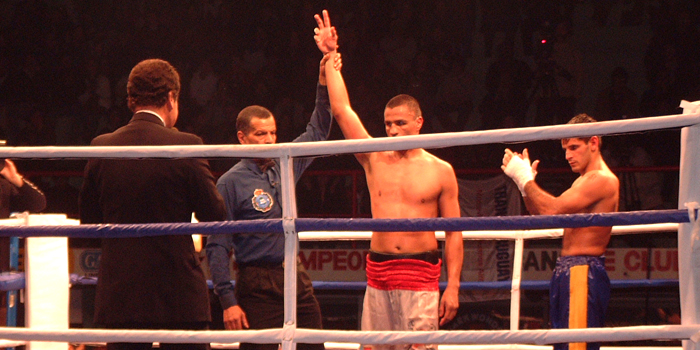
Having worked with boxers ranging from youth amateurs, Olympic gold medalists and professional world champions, I've learned one thing; there are very few common traits among boxers concerning their strength and conditioning programs. A few lift big weights, others only do bodyweight training, many run long distances, and some do nothing at all but box. I'm going to lay out the philosophy our team uses with our boxers and the standards that we demand of them.
The foundation of our program is that boxing comes first, everything we do in strength and conditioning is supplemental to the boxing training and the recovery from that training. Don't get me wrong, soreness and fatigue are okay and often necessary, however they shouldn't impair the work done in sparring or with the mitts. The ability to recover quickly is dependent on another one of our priorities, conditioning.
Fatigue makes cowards of us all – Vince Lombardi
Ask any boxer at any time if they're in shape; the answer will always be yes. To put it politely, I've found that athletes can have some pretty loose interpretations of what being in shape means. So what is 'in shape'? Our standard for pro's is that they can spar twelve rounds while we cycle in three or four fresh opponents. For an amateur, the standard is six rounds. The reason for six is because even though they only fight three rounds for men or four rounds for women, they have multiple fights in a tournament. Aerobic conditioning is primarily the energy system that aids recovery from session to session. It is important to understand that these standards of conditioning are for the beginning of camp, so six to eight weeks before the fight. Camp is not for getting into shape, camp is for sharpening the blade. The top pro's that I work with could spar twelve rounds in this fashion any day of the year. If you're not at this level of conditioning an easy method to employ is three or four days a week of circuit work that keeps the heart rate between 140-150 beats per minute for 60 minutes. Intense sparring should be done on the other two or three days. Be sure to give yourself one day off to rest and recover. Typically, an athlete should only need two weeks of this type training to reach the sparring standards, so in a pinch, employ these methods the tenth and ninth weeks out from the fight.
Now that we are satisfied with our fighters conditioning at the beginning of camp, we must keep them healthy. Camp is an intense grind and anything that is a little banged-up at eight weeks out, will be brutal by fight night if we don't attack it. There are several common areas that boxers experience discomfort; feet/ankles, knees, low back and shoulders are the ones I've seen the most. Joint health and performance is dependent on the balance between flexibility and strength of the surrounding muscles. I'll provide examples for each of the common areas listed above and some of the ways we address them.
Feet/ankles – Boxers are always on their toes, this causes chronic tightness in the muscles on the underside of the foot, Achilles tendon and calves. A great stretch for this is prop your foot up against the base of a wall and then lean into the stretch. It’s even better if you can put the big toe into extension. You can use a straight knee or bend it and move it forward/backward and side to side. 30 seconds each leg, as part of warm-up and at end of training should suffice.
Knees – often by increasing the flexibility of the feet/ankles, knee pain will be relieved. There are many reasons for knee pain, many of which are much too in-depth for this article. Generally speaking tightness in the feet/ankle, quads or IT Band are the cause of the problem with boxers. Boxing requires a stance and movement where the right leg is taxed differently from the left and certain muscle groups are constantly being stressed. This constant stress leads to tight muscles, which increase strain on the knee. Think of your muscles like ropes; if I tie a rope around your neck and leave slack in the rope – your neck feels fine. If I pull the rope – your neck hurts. There's nothing wrong with your neck, it's the rope pulling on it, loosen the rope and your neck stops hurting. This is often true of knee pain. If your knee hurts in the front, stretch the quads and hip flexors really well. If it hurts on the outside, stretch your IT Band and stretch the groin for inside knee pain. In conjunction with flexibility work do some glute and hamstring strengthening. Great exercise choices are back bridges, Cook hip lifts, pull-throughs, back extensions, sled dragging and reverse hypers. Again, this is the simple answer, but it's a great place to start. More often than not, boxers I meet lack flexibility in their lower body and strength in their hips.
Low Back – the most common culprits of low back pain are tight hip flexors, psoas, hamstrings and IT Bands along with a need for greater strength in the glutes and abs. The same strength exercises listed for glutes in the knee section will work here as well. Abdominal or 'core' training should focus on stability, especially if there is pain present or the athlete is in rehabilitation. Repetitive flexing of the spine such as in sit-ups or crunches may increase pain levels. Beginning standards for stabilization are being able to hold a front bridge for two minutes and a lateral bridge for 90 seconds each side, with no movement or hip drop in either exercise.
Most of our strength program addressing the low back is based on the work of Dr. Stuart McGill. I would strongly recommend any athlete or coach to get his book Ultimate Back Fitness and Performance, or at least research some of his videos and articles on the Internet.
Shoulders - because of the stance and movements in boxing, the pectorals and lats become tight and need regular flexibility work. Increasing strength in the external rotators, rhomboids as well as the mid and lower traps will help stabilize the scapula and reduce stress in the shoulder joint. The exercises we use to keep the shoulders strong and healthy are; inverted rows, variations of dumbbell & cable rows, YTWLs, face pulls, thoracic mobilizations, band shoulder mobilizations and 4-way scaption to name a few.
Cramping – Some people are genetically more susceptible to cramps, but it can be controlled. If a boxer has a history of cramps, they need to review the training camp leading up to the fight where cramping occurred. The main factors to be evaluated are fluctuations in bodyweight and hydration, mineral deficiencies, changes in muscle tension/flexibility and conditioning levels. We have never had a fighter cramp up because we have great attention to detail in these areas.
Keeping the feet/ankles, knees, low back and shoulders healthy in boxers is a constant challenge that will be present during their entire career and must be addressed on a regular basis, even as a preventative measure. During camp our boxers only go to the weight room two times a week, but we work on the above areas everyday as part of our warm-ups and at the end of training. We will also do extra workouts to address areas that need more attention. The extra workouts only last 10-15 minutes and are focused on only one area per session. For instance, an athlete with low back pain will do glute activation, hip mobility, core stability and psoas release each morning after breakfast but several hours before we go to the gym. All areas of need are trained at least once per day and commonly three times a day, six days a week for the entire camp. Out of camp, we have the boxers keep up with their program four days a week minimum.
We start each session by using foam rollers, golf balls, lacrosse balls and the peanut to do our myofascial release program. The athlete spends five to ten minutes before warm-ups rolling out any tight muscles or stiff areas. Next we do our dynamic warm-up, then after training we static stretch the whole body, holding each stretch for a minimum of thirty seconds. So you can see that we spend a lot of time and energy keeping our boxers healthy, but in four years we’ve never lost training time to injury. Avoiding the setbacks of injury allows us to progress in the future.
Obviously, the goal of each camp is to win the fight, but we also continue developing physically, mentally and in our daily habits, from camp-to-camp. I meet with the boxers and trainers to reevaluate the last camp so we can make necessary adjustments build upon what has been working and to understand the goals/strategies of the upcoming fight. Each camp our boxers are stronger and able to handle a greater complexity of training. Our program has evolved greatly over the last four years, due to our long-term approach, tracking all sets and great dedication by the boxers year round. In our program it's important that the boxer understands what we're doing, why we're doing it, and the physiological response we're looking for. This way they learn how to train between camps when we may be living in different areas.
Rob Schwartz is the Strength and Conditioning Coach/Sports Nutritionist for Adrien Broner and other Boxers trained by Michael Stafford since early 2011. In that time Broner has won 3 World Championships and the team's record is 48-1. From 2009 to 2013 Schwartz was Director of Strength and Conditioning within the United States Olympic Committee – Combat and Acrobatic Sports responsible for 23 National Teams. Prior to the Olympics he was the Head Strength and Conditioning Coach/Nutritionist for Northern Arizona University. Rob has also coached in 3 FBS programs, the Cleveland Indians and US Army Special Forces. Schwartz did his undergrad at Bowling Green State University as well as his Master's program at the University of Houston. He can be reached at Schwartz.rob@gmail.com.










